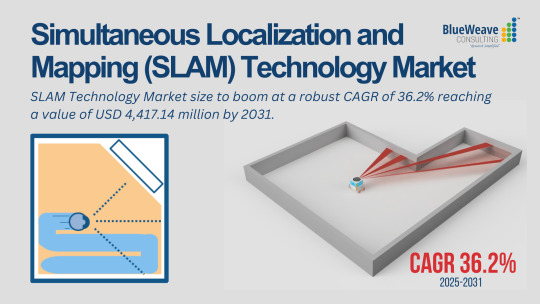#SLAMTechnologyMarket
Explore tagged Tumblr posts
Text

Simultaneous Localization and Mapping (SLAM) Technology Market size at 654 million in 2024. During the forecast period between 2025 and 2031, BlueWeave expects Global Simultaneous Localization and Mapping (SLAM) Technology Market size to boom at a robust CAGR of 36.2% reaching a value of USD 4,417.14 million by 2031. The growing advancements in computer vision, growing adoption of intelligent robots, and a surging demand for autonomous navigation across diverse sectors such as automotive, robotics, and augmented reality are the major driving forces behind Global Simultaneous Localization and Mapping (SLAM) Technology Market. The SLAM technology empowers machines to perceive their environment in three dimensions, enabling precise navigation and mapping. SLAM systems primarily utilize LiDAR or visual sensors, each offering unique advantages. LiDAR SLAM delivers high-precision mapping with minimal errors, making it ideal for indoor applications, while Visual SLAM is more cost-effective, adaptable to various environments, and provides rich semantic data, though it requires adequate lighting. Hybrid approaches that combine both technologies are gaining popularity to optimize overall performance. The expanding use of SLAM in robotics, including drones, warehouse automation, and industrial robots, is further propelling market growth. Industry leaders, such as Ryan Gariepy, Co-Founder and CTO of Clearpath Robotics, emphasize SLAM's crucial role in enabling autonomous robots to navigate and interact intelligently with their surroundings. This capability enhances their value across a wide range of applications, from logistics to agriculture.
Sample Request: https://www.blueweaveconsulting.com/report/simultaneous-localization-and-mapping-technology-market/report-sample
Opportunity - Spurring Demand for SLAM in Healthcare and Construction Sectors
The growing demand for simultaneous localization and mapping (SLAM) technology is fueling the market growth in major industry verticals, such as healthcare and construction. As industries increasingly integrate autonomous robotics and real-time sensing systems, SLAM technology plays a pivotal role in enhancing operational efficiency and precision. In healthcare, for instance, SLAM is being utilized in medical robots for tasks such as surgical assistance, rehabilitation, and diagnostics. These robots depend on SLAM’s ability to map environments and track movements with high accuracy, contributing to safer and more efficient healthcare practices. Similarly, in the construction industry, SLAM technology has transformed site inspections and material handling. Robotics equipped with SLAM systems can navigate complex construction environments, performing tasks such as mapping building structures, detecting structural anomalies, and assisting in Building Information Modeling (BIM). The ability to create accurate, real-time maps improves productivity, reduces errors, and ensures higher-quality construction outputs. These advancements illustrate how SLAM technology is becoming indispensable across various industries, opening up significant opportunities for growth in the Global SLAM Technology Market.
#BlueWeave#Consulting#Marketforecast#Marketresearch#Innovation#SLAMTechnologyMarket#NavigationTechnology#AutonomousSystems#Robotics#ArtificialIntelligence
0 notes